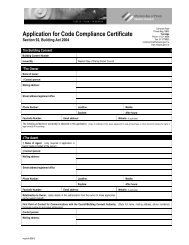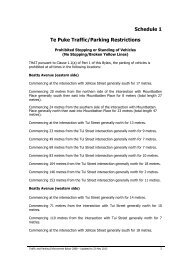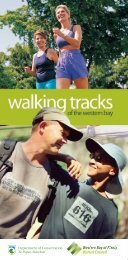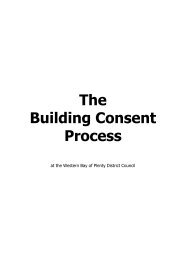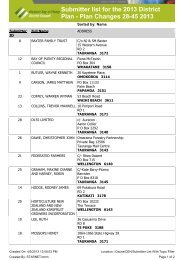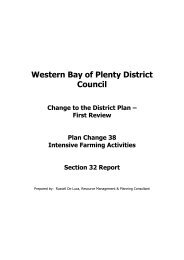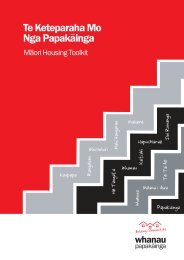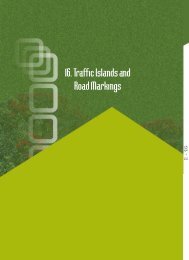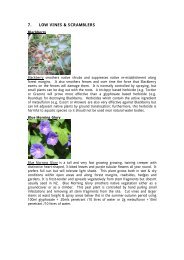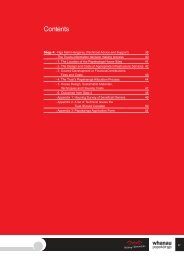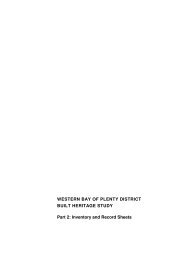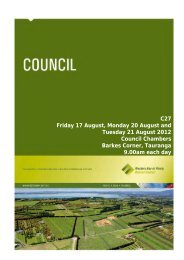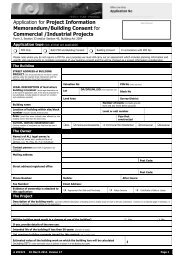Te Puna Plan - Western Bay of Plenty District Council
Te Puna Plan - Western Bay of Plenty District Council
Te Puna Plan - Western Bay of Plenty District Council
Create successful ePaper yourself
Turn your PDF publications into a flip-book with our unique Google optimized e-Paper software.
Appendix 5<br />
What is Rural Character?<br />
(f)<br />
(g)<br />
That generally do not require the extension <strong>of</strong> urban government services; and<br />
That are consistent with the protection <strong>of</strong> natural surface water flows and<br />
ground water and surface water recharge and discharge areas.”<br />
The approach<br />
While the theory <strong>of</strong> “carrying capacity” is relatively straight forward, its application to a diverse rural<br />
area like <strong>Te</strong> <strong>Puna</strong> is less so.<br />
Community input will drive a local perception <strong>of</strong> essential character. This needs to be combined with<br />
relevant research. This is the focus <strong>of</strong> the next section <strong>of</strong> this <strong>Plan</strong>.<br />
What do we currently know about ‘essential character’?<br />
Essential character, for <strong>Te</strong> <strong>Puna</strong>, is seen as rural character. While ‘rural character’ can mean<br />
different things to different people, most agree that it compromises a sense <strong>of</strong> openness ie<br />
unplanned, non-uniform, natural and non-urban.<br />
The New Hampshire Office <strong>of</strong> Energy and <strong>Plan</strong>ning, Washington, USA 4 defines rural character<br />
as:<br />
“14) ‘Rural character’ refers to the patterns <strong>of</strong> land use and development established by a<br />
county in the rural element <strong>of</strong> its comprehensive plan:<br />
(a)<br />
(b)<br />
(c)<br />
In which open space, the natural landscape, and vegetation predominate over the<br />
built environment;<br />
That foster traditional rural lifestyles, rural-based economies, and opportunities to<br />
both live and work in rural areas;<br />
That provide visual landscapes that are traditionally found in rural areas and<br />
communities;<br />
Edge Land <strong>Plan</strong>ning, Australia 5 explores the definition <strong>of</strong> rural land and rural character:<br />
“What is Rural Land?<br />
This is a question that has as many answers as there are people who are involved in Rural <strong>Plan</strong>ning.<br />
The crudest definition is that rural land is all land that is not urban. However, that is too simplistic for<br />
any definition <strong>of</strong> rural land. Wide open land, Farmland, Forests, National Parks, Mountains, River<br />
banks, Lakeshores, Urban Fringe and Rural Residential areas all make up the landscape that we<br />
describe as rural. It is not any one landform or land use. It is the mixture <strong>of</strong> them that evokes the<br />
term Rural Land.<br />
They can be grouped under the following headings:<br />
<br />
<br />
<br />
<br />
<br />
<br />
<br />
<br />
<br />
agricultural uses and activities<br />
scenery and landscape<br />
sense <strong>of</strong> peace<br />
lifestyle<br />
density<br />
food and clothing<br />
problems<br />
biodiversity<br />
climate<br />
The thing to note is that everybody has a different definition <strong>of</strong> rural land, depending on a range <strong>of</strong><br />
things such as their background, age, where they live, etc.<br />
The main feature <strong>of</strong> rural land is that it has an unplanned, non-uniform, natural look and can be<br />
described as “chaotic”. This describes rural land the most accurately – it is a mixture <strong>of</strong> uses where<br />
no one use is the dominant one. You can say that the dominant use is rural!<br />
(d)<br />
(e)<br />
That are compatible with the use <strong>of</strong> the land by wildlife and for fish and wildlife<br />
habitat;<br />
That reduce the inappropriate conversion <strong>of</strong> undeveloped land into sprawling, lowdensity<br />
development;<br />
What is Rural Character?<br />
Rural Character is a term that is <strong>of</strong>ten misunderstood and misused when applied to rural land. Rural<br />
character is made up <strong>of</strong> a number <strong>of</strong> components – the one thing they have in common is the feeling<br />
<strong>of</strong> openness. They include the following:<br />
4 Internet Reference } State the reference link<br />
5 Internet Reference }<br />
<strong>Te</strong> <strong>Puna</strong> Community <strong>Plan</strong> March 2007 Page 28



